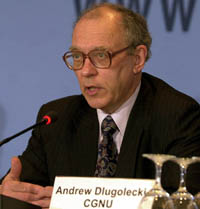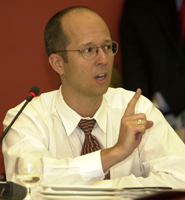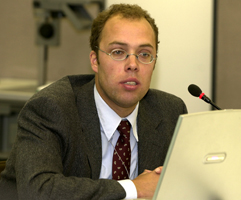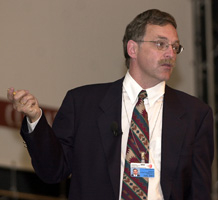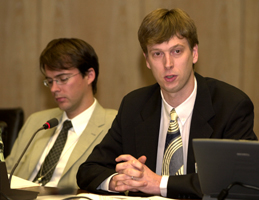|
|
|||||||||||||||||||||||||||||||||||
|
|||||||||||||||||||||||||||||||||||
|
Events convened on Wednesday, 18 July 2001 |
|
The
financial sector and climate change Presented by the Insurance Initiative in association with UNEP
At this event, financial companies belonging to UNEP's Finance Initiatives' Climate Change Working Group delivered presentations highlighting their achievements, explaining their position on climate change, and providing case studies. Thomas
Loster, Munich Re, addressed threats and opportunities for the
financial sector as a result of climate change. He noted a drastic
increase in the magnitude and frequency of major economic losses
due to natural disasters during the past decade, and emphasized
that climate change impacts are likely to exacerbate the problem.
He stated that if current trends continue, annual losses could
approach US$150 billion over the next decade, and as a result,
the insurance industry will have to raise rates and impose restrictions,
such as significant deductibles and low liability limits. He
suggested that the additional cost burden would be shared between
individuals and governments. Andrew
Dlugolecki, CGNU, explained that the Climate Change Working
Group is currently updating its position statement, which is
driven by the precautionary principle and reflects the significant
risks of climate change on human health, the economy, and the
environment. Dlugolecki underscored the financial industry's
willingness to support the shift to energy efficiency and renewables,
and stated that governments can facilitate this shift by establishing
long-term frameworks to reduce emissions. Ivo Knoepfel,
Sustainable Asset Management, described the first global stock
market index that screens corporations' greenhouse gas (GHG)
emissions and contributions to protecting the climate. He highlighted
exponential growth in both renewable energy investments and
socially responsible investments, but emphasized the need for
greater transparency about use and application of screens. He
noted good performance of stock prices for alternative energy
companies, and envisioned energy as the next big theme in capital
markets. Pablo Cardinale Pizani, Corporation Andino de Fomento (CAF), presented a case study of the Latin American Carbon Programme. To initiate a carbon market in Latin America, CAF uses its profits as venture capital for carbon mitigation projects, such as the construction of a subway system and a natural gas fueled generating plant. More
information: |
|
Small projects under the CDM: Opportunities and barriers Presented by the Energy Research Centre of the Netherlands (ECN) in collaboration with IT Power
This event explored opportunities for small renewable energy and energy efficiency projects under the Clean Development Mechanism (CDM). Jan-Willem Martens, ECN, discussed streamlined CDM procedures for off-grid solar home systems (SHSs) in developing countries. He said the CDM should promote small projects, as they have a higher development impact, are more likely to reach poor households, and achieve real reductions and long-term climate benefits. However, significant barriers exist, including high transaction costs, complex procedures, and distance to target groups. Martens emphasized that the role of UNFCCC Parties in this regard is to assist projects in developing CDM procedures; raise awareness among relevant industries; stimulate proactive CDM policy focused on off-grid renewables and small-scale energy efficiency in developing countries; and mobilize dedicated funding for small projects. James Plastow, IT Power, spoke on enabling small-scale CDM projects in least developed countries. He underscored that the purpose of the CDM is to assist non-Annex I Parties to achieve sustainable development. To reduce transaction costs, small-scale projects can be bundled together and procedures simplified.
Mark van Wees, ECN, addressed the chances for end-use energy efficiency projects under the CDM. He emphasized that most energy efficiency market transformation programmes fulfill environmental and development criteria and are satisfactory for the CDM. However, the competitive position of these programmes in the CDM is weak compared to supply-side projects, given the greater interest by many potential investors in energy supply and conversion projects. He said improvement is possible through streamlined fast-track procedures and greater involvement by the energy efficiency industry. He outlined three steps for such projects to achieve competitive success in the CDM: developing all aspects of the project; generating certified emissions reductions (CERs), including a baseline and monitoring; and selling CERs. Discussion: Participants discussed the viability and economic feasibility of SHS projects for the CDM, and whether there should be up-front crediting for these projects. The importance of standardizing baselines was emphasized.
More
information: Please visit the UNFCCC's
"On Demand" website for RealVideo coverage of
this event
|
|
Special presentation on the IPCC Third Assessment Report Climate Change 2001 - Mitigation Presented by the Intergovernmental Panel on Climate Change (IPCC)
This special presentation provided an overview of the contribution of IPCC Working Group III (WGIII) to the IPCC Third Assessment Report (TAR). Ogunlade
Davidson, Co-Chair of IPCC WGIII, summarized the main messages
of the WGIII TAR, including the strong link between sustainable
development policies and climate change mitigation, and the
ability of modern technologies to limit the increase of global
GHG emissions.
John Robinson,
University of British Columbia, outlined a framework for integrating
sustainable development and climate change mitigation. Preliminary
findings show that placing climate change mitigation in a sustainable
development context will improve prospects for achieving both
climate change mitigation and sustainable development goals.
He noted that although sustainable development policies may
affect GHG emissions and mitigative capacity, mitigation directly
affects sustainable development prospects, such as employment,
welfare, and intergenerational issues. He indicated that a slower
rate of mitigation can reduce shock effects and reduce costs,
but that a faster rate can spur technological growth. José
Roberto Moreira, Brazilian Biomass Users Network, discussed
technological and biological mitigation potentials and opportunities.
He noted a decoupling between economic growth and per capita
CO2 emissions in some countries, but
said this was insufficient to slow growth in global CO2
emissions. Moreira outlined examples of mitigation options in
energy efficiency, decarbonization of energy sources, CO2
removal and storage, biological carbon sequestration, and reduction
of other GHGs from industry, agriculture and waste management.
He stressed that significant reductions of GHG emissions can
be technologically and economically achieved in all sectors
in the near term. Technologies are currently available to mitigate
climate change in the long term, but it is necessary to overcome
political, economic, social and behavioral barriers to implementing
mitigation options. Terry Barker,
Cambridge University, presented on the costs and benefits of
climate change mitigation. He addressed ancillary benefits and
the direct benefit of avoided damages from climate change, but
noted that a comprehensive assessment was not yet feasible.
Barker noted wide variations in mitigation costs between countries
and sectors, and stressed the importance of baselines in stabilization
scenarios. He concluded that, despite widely varying costs across
regions and sectors, many options exist to effectively reduce
GHG emissions with minimal effect on GDP growth, provided that
they are well planned and enacted early. Jayant Sathaye, Lawrence Berkeley National Laboratory, discussed ways and means for achieving climate change mitigation. He reiterated that there is significant potential to reduce CO2 emissions, but stressed that realizing this potential requires overcoming market, institutional, social and cultural barriers. He noted that identifying barriers can aid in the development of sharper and more targeted policies, measures and instruments, and that removing barriers during capital stock turnovers and periods of rapid social change can minimize disruption and mitigation costs. He emphasized that the cost of barrier removal increases estimated bottom-up costs, and explicit consideration of barriers can reduce top-down cost estimates. More
information: Please
visit the UNFCCC's
"On Demand" website for RealVideo coverage of
this event
|
|
Forestry issues arising from COP-6 Presented by the International Emissions Trading Association (IETA)
Robert Dorneau, IETA, introduced this event, which addressed the credibility and environmental integrity of forests and carbon trading following COP-6. Edwin Aalders, Societé Général de Surveillance (SGS), presented a paper on "Forestry Issues Outstanding from COP-6," which provides an analysis of the "issues" set out in COP-6 President Jan Pronk's proposals related to implementation of afforestation and reforestation projects under the CDM. Aalders tackled key areas, including: non-permanence and accounting modalities; social and environmental effects; leakage; additionality; uncertainty; and scale. In addressing Pronk's "issues," he provided potential technical solutions and emphasized that SGS has considerable experience in the validation and certification of potential CDM projects in the land use, land-use change and forestry sector. On that basis, he noted that SGS strongly supports the inclusion of afforestation and reforestation under the Kyoto Protocol. Igino Emmer, Forests Absorbing Carbon Dioxide Emission (Face) Foundation, addressed the issue of forest sinks and the potential for a Dutch voluntary carbon market. He illustrated that project sustainability specifically relies on: project design; socioeconomic sustainability, including long-term commitments of stakeholders; and contract length. Deliberating on project experience, he stressed that project design and partnerships are key to the permanence of sinks. He also noted that socioeconomic sustainability should consider local community needs. On certification and verification, he noted that Face's project criteria relied on Forest Stewardship Council standards for sustainable forest management and social impact assessment, and added that Face's projects have been assessed under SGS' GHG Project Verification & Certification criteria and fulfill Kyoto Protocol compliance criteria. He stated that benefits of verification and certification include improvements in project management as well as increased transparency and certainty of CO2 credits. Due to developments in the climate treaty and the current "non-value" of credits, he noted a new approach to voluntary markets aiming at current incentives, such as CO2-neutral manufacturing and transport. More
information: |
|
|
|
| The Earth Negotiations Bulletin (ENB) on the side is a special publication of the International Institute for Sustainable Development (IISD) in cooperation with the United Nations Framework Convention on Climate Change (UNFCCC) Secretariat. The Editor of ENB on the side is Kira Schmidt <kira@iisd.org>. This issue has been written by Emily Boyd <emily@iisd.org>, Fiona Koza <fiona@iisd.org>, Prisna Nuengsigkapian <prisna@iisd.org> and Kira Schmidt <kira@iisd.org>. The Digital Editors are Andrei Henry <andrei@iisd.org> and Kenneth Tong <ken@iisd.org>. Photos by Leila Mead <leila@iisd.org>. Funding for publication of ENB on the side at COP-6 Part II is provided by the UNFCCC Secretariat. The opinions expressed in ENB on the side are those of the authors and do not necessarily reflect the views of IISD and funders. Excerpts from ENB on the side may be used in non-commercial publications only and only with appropriate academic citation. For permission to use this material in commercial publications, contact the Managing Editor at <kimo@iisd.org>. Electronic versions of these issues of ENB on the side from COP-6 Part II can be found on the Linkages WWW server at http://enb.iisd.org/climate/cop6bis/enbots/. | |
|
|
| © 2001, IISD. All rights reserved. |
|



